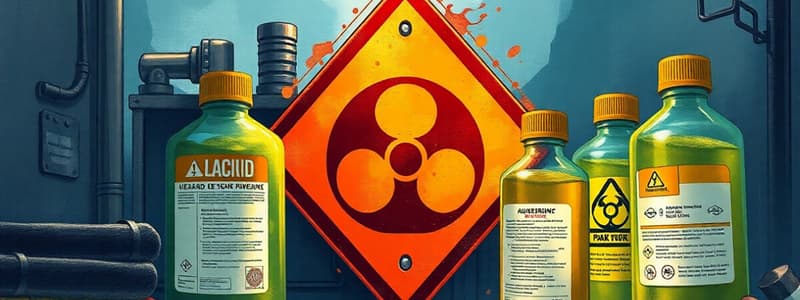Podcast
Questions and Answers
What is the primary language that workplace labels must be in?
What is the primary language that workplace labels must be in?
Which step is NOT part of the label creation process under the revised HCS requirements?
Which step is NOT part of the label creation process under the revised HCS requirements?
Employers are allowed to use which of the following on workplace labels?
Employers are allowed to use which of the following on workplace labels?
What additional pictograms may employers list on labels for protective measures?
What additional pictograms may employers list on labels for protective measures?
Signup and view all the answers
Which of the following does NOT need to be consistent with the Hazard Communication Standard?
Which of the following does NOT need to be consistent with the Hazard Communication Standard?
Signup and view all the answers
What does the signal word 'Danger' signify on a hazardous chemical label?
What does the signal word 'Danger' signify on a hazardous chemical label?
Signup and view all the answers
Which of the following must be included on a hazardous chemical label?
Which of the following must be included on a hazardous chemical label?
Signup and view all the answers
How many signal words can appear on a hazardous chemical label?
How many signal words can appear on a hazardous chemical label?
Signup and view all the answers
What do hazard statements describe on a chemical label?
What do hazard statements describe on a chemical label?
Signup and view all the answers
When multiple hazards exist, which signal word should appear on the label if one hazard warrants 'Danger' and another warrants 'Warning'?
When multiple hazards exist, which signal word should appear on the label if one hazard warrants 'Danger' and another warrants 'Warning'?
Signup and view all the answers
Which appendices are mandatory for developing hazardous chemical labels?
Which appendices are mandatory for developing hazardous chemical labels?
Signup and view all the answers
What does Appendix A cover in the context of chemical labeling?
What does Appendix A cover in the context of chemical labeling?
Signup and view all the answers
Which of the following statements about hazard statements is true?
Which of the following statements about hazard statements is true?
Signup and view all the answers
What is the purpose of precautionary statements on chemical labels?
What is the purpose of precautionary statements on chemical labels?
Signup and view all the answers
What was the main goal of the revised Hazard Communication Standard?
What was the main goal of the revised Hazard Communication Standard?
Signup and view all the answers
Which of the following elements must be included on chemical labels under the new standard?
Which of the following elements must be included on chemical labels under the new standard?
Signup and view all the answers
When did the requirement for labeling hazardous chemicals under the revised standard officially take effect?
When did the requirement for labeling hazardous chemicals under the revised standard officially take effect?
Signup and view all the answers
What change did the revised Hazard Communication Standard implement regarding compliance for distributors?
What change did the revised Hazard Communication Standard implement regarding compliance for distributors?
Signup and view all the answers
What aspect of information delivery did the revised standard emphasize on chemical labels?
What aspect of information delivery did the revised standard emphasize on chemical labels?
Signup and view all the answers
What flexibility was provided to manufacturers, importers, and distributors before the effective date of the revised standard?
What flexibility was provided to manufacturers, importers, and distributors before the effective date of the revised standard?
Signup and view all the answers
How does the revised Hazard Communication Standard approach the classification and labeling of chemicals?
How does the revised Hazard Communication Standard approach the classification and labeling of chemicals?
Signup and view all the answers
What must workplace labels include when created by employers?
What must workplace labels include when created by employers?
Signup and view all the answers
In what situation are no labels required for a portable container?
In what situation are no labels required for a portable container?
Signup and view all the answers
What must an employer ensure if using NFPA or HMIS labeling systems?
What must an employer ensure if using NFPA or HMIS labeling systems?
Signup and view all the answers
If an employer continues to use their workplace labeling system, what must they have accessible to employees?
If an employer continues to use their workplace labeling system, what must they have accessible to employees?
Signup and view all the answers
What labeling methods can employers use instead of manufacturer labels?
What labeling methods can employers use instead of manufacturer labels?
Signup and view all the answers
What do manufacturers determine when classifying a chemical?
What do manufacturers determine when classifying a chemical?
Signup and view all the answers
What is required on the label once the chemical classification is determined?
What is required on the label once the chemical classification is determined?
Signup and view all the answers
What happens if a labeling system meets the requirements of HazCom 1994?
What happens if a labeling system meets the requirements of HazCom 1994?
Signup and view all the answers
What constitutes the information that must be provided to employees regarding hazardous chemicals?
What constitutes the information that must be provided to employees regarding hazardous chemicals?
Signup and view all the answers
Which of the following is not a valid method of workplace labeling?
Which of the following is not a valid method of workplace labeling?
Signup and view all the answers
What is the purpose of signal words on a label?
What is the purpose of signal words on a label?
Signup and view all the answers
Which statement is true regarding combining precautionary statements on labels?
Which statement is true regarding combining precautionary statements on labels?
Signup and view all the answers
When can an employer include additional chemical information on a label?
When can an employer include additional chemical information on a label?
Signup and view all the answers
Which of the following actions is NOT recommended on a precautionary statement?
Which of the following actions is NOT recommended on a precautionary statement?
Signup and view all the answers
What should be included if the classification of an ingredient is not based on testing the entire mixture?
What should be included if the classification of an ingredient is not based on testing the entire mixture?
Signup and view all the answers
What might be considered 'supplementary information' on a label?
What might be considered 'supplementary information' on a label?
Signup and view all the answers
Which phrase describes a permissible action by OSHA concerning precautionary statements?
Which phrase describes a permissible action by OSHA concerning precautionary statements?
Signup and view all the answers
Which of the following is NOT a goal of creating precautionary statements?
Which of the following is NOT a goal of creating precautionary statements?
Signup and view all the answers
What is NOT required for a workplace label format?
What is NOT required for a workplace label format?
Signup and view all the answers
Why might precautionary statements vary in their presentation?
Why might precautionary statements vary in their presentation?
Signup and view all the answers
Study Notes
Hazard Communication Standard: Labels and Pictograms
- OSHA has updated the Hazard Communication Standard (HCS), aligning it with the Globally Harmonized System of Classification and Labelling of Chemicals (GHS).
- The revised standard, effective June 1, 2015, requires new labeling elements which include hazard pictograms, signal words, and hazard/precautionary statements.
- Existing labels can be used until June 1, 2015.
- Distributors can continue using HazCom 1994 containers until Dec 1, 2015.
- All the containers leaving a workplace need to be labeled, tagged, or marked with the product identifier, signal word, hazard statement(s), precautionary statement(s), and pictogram(s), and the name, address and telephone number of the responsible party.
- Labels are written, printed or graphic information that's attached to containers.
- Pictograms are graphic symbols that communicate hazard information.
- Safety Data Sheets (SDSs) provide detailed information about the chemical (16 sections).
Label Requirements
- Labels must include the name, address, and phone number of the chemical manufacturer, importer, or other responsible party.
- A product identifier, such as the chemical name, code number, or batch number, is required, and it needs to be consistent with the SDS.
- One signal word ("Danger" or "Warning") is used, depending on the severity of the hazard.
- Hazard statements describe the nature of hazards, including the extent of the hazard.
- Precautionary statements provide recommendations to minimize or prevent adverse effects.
Pictograms and Hazards
- OSHA will utilize eight of the nine GHS pictograms for mandatory use.
- Environmental pictograms are not mandatory but can be used for additional informative purposes.
- Pictograms, names, and hazards are shown in a figure.
Employer Responsibilities
- Employers are responsible for maintaining labels on containers to ensure legibility and correct hazard information. Labels should not be defaced or removed.
- If new hazards are identified, labels must be updated.
- Employers can continue to use HazCom 1994 labeling if their current system meets the requirements.
- Workplace labels can meet 1994 standards or be created by employers.
- If a chemical is transferred to a portable container used solely by the user, no label is needed.
- OSHA allows use of NFPA or HMIS labeling if consistent with HCS.
Studying That Suits You
Use AI to generate personalized quizzes and flashcards to suit your learning preferences.
Related Documents
Description
Test your knowledge of the Hazard Communication Standard and its updates under OSHA. This quiz covers essential labeling elements, including hazard pictograms, signal words, and precautionary statements that are vital for workplace safety. Make sure you're familiar with the requirements effective from June 1, 2015.




